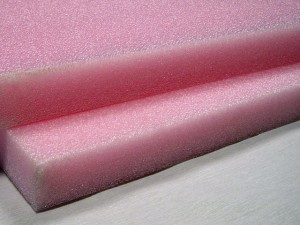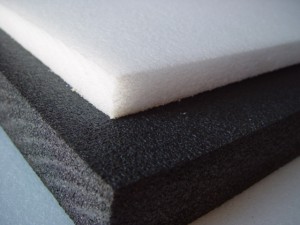The world of foam polymers can be a complicated one, with minor differences in structure, additives and molecular makeup creating completely different products. Because the forming of these materials can be manipulated in so many ways, highly-specialized products for unique jobs are often created, with only a slight change in formulation tailoring them to a certain application. The benefit of this is that users rarely have to compromise on a material that only meets some of their requirements. The drawback however, is trying to find that perfect product among a litany of similar materials. For this reason, the U.S. General Services Administration introduced Commercial Item Description A-A-59135 and A-A-59136 in 1997, superseding the existing standard.

The A-A-59136 standard, which specifically addresses the categorization and traits of “Cushioning Material, Packaging, and Closed-Cell Foam Plank,” utilizes a three-tiered system for identifying material type and characteristics to make differentiating these products much simpler. Meanwhile, the A-A-59135 standard covers “Packaging Material, Sheet,” pertaining more specifically to dunnage applications. These commercial item descriptions are different from some other standards that measure capability. Instead of evaluating materials, they merely categorize and define products for easier identification, after having their performance characteristics evaluated.
A-A-59136, directed at “cushioning and packaging applications,” breaks identifiers into three sections: Class, Grade and Type. With four sub-categories to define a material under each of these listings, this format not only makes identifying proper materials easy, it also helps when comparing and contrasting products. The first value is Class, which identifies the type of foam material. While this seems obvious, the similarities of foam materials can make confusing one product for another relatively easy. Class 1 is general purpose polyethylene closed-cell foam, Class 2 is general purpose polypropylene and Class 3 is general purpose material, specified by its procuring activity. These materials are all in an uncut state. There is a fourth Class that includes special purpose forms that have already been processed and cut, specified by their procuring activities. These designations are beneficial for situations where companies brand their products, making it difficult to identify the actual material. If a material is labeled Class 1 for example, no matter what a company has named their product, it is polyethylene foam.
The second category A-A-59136 includes is Grade. This assigns traits to the previously specified foam type. Being cushioning and packing materials, the foam types covered will encounter any number of products that may require special characteristics to ensure packaging safety in transit or storage. The Grade assigned to a material states what, if any, specialized traits a foam possesses. Grade A means a standard, untreated material. Grade B means the material contains static dissipating characteristics, important for the packaging of sensitive electronics. These anti-static foam materials prevent the buildup of potentially damaging electro-static charges generated by other products, handlers or even the product itself. Grade C means the foam inserts have fire retarding characteristics, beneficial and often required for insulating applications. Grade D classification means the material has both anti-static and flame retardancy characteristics. These values make it easy to see if the characteristics of a product meet the specifications for a job and also help standardize requests for products through uniformity.
The third classification in this standard is Type, which refers to the compression creep of a material, or the permanent deformation of a material under stress. The parameters of this value indicate a material’s average creep should not be greater than 10 percent of its original thickness after 168 hours of testing. The assigned values correlate to the weight required to create that 10 percent creep. Type I requires 14 Kg, Type II 21 Kg, Type III 25 Kg and Type IV 37 Kg. These values are one way of categorizing a material’s strength, the only interpretation of performance capability in the standard.
A-A-59135 meanwhile, specifies its application as being more towards dunnage; the packaging used around items in transport by freight, rail or waterways. Just as important as ensuring a product’s packaging is secure is securing the packaged shipment in transit. Damaged products cost consumers, retailers and manufacturers massive amounts of money every year, so safely securing product shipments is just as important as securing the product itself.

This commercial item description states that a packaging material’s performance depends on its application and other factors. Because of that, the scope of materials included is much wider than what is found in A-A-59136, including starch based sheet material and paper or cellulose sheet material in addition to more traditional polypropylene and polyethylene plank foams. A-A-59135 uses a similar organizational structure for classifying materials, though it is more simplified than A-A-59136, without a Type classification. There are five classes, with Class 1 being general purpose polyethylene sheet material, and the others being an assortment of other foam, paper and uniquely specified materials. The Grade designations are identical to A-A-59136 however, with Grade A being a standard material, Grade B being anti-static, Grade C being fire retardant and Grade D being both anti-static and fire retardant. These characteristics are as important for dunnage as they are for specific packaging applications, considering the multitude of ways a shipment can be transported and the forces and environments that may be encountered.
The benefit of these material classifications and ratings is that they are able to be turned into a code that allows very similar materials to be classified, compared and identified. It helps take ambiguity and miscommunication out of ordering materials, by making it very clear what each Class, Grade and Type means. Using this standard for example, an individual looking for fire retardant polypropylene for cushioning material can contact sellers with a request for a Class B, Grade C material, greatly reducing margin for error. By making these designations black and white, materials simply will or will not have these applied values. All that needs to be specified in addition to the classification code is which description number you are using, A-A-59136 or A-A-59135. It also allows manufacturers to list products and organize their inventory according to the categories, simplifying their processes. A classifying system such as this is beneficial to consumers, retailers and manufacturers alike, and helps to simplify what can become a potentially confusing process.
Note: This post is to be viewed as a general overview of these specifications, and not intended to explicitly suggest or implicitly imply that Foam Factory carries products that meet any or all of the requirements stated in the noted documents.


Hello. I am in need of price and delivery on the following spec and size. Please quote your closest dimensions if you can’t do the size rquested.
I am in need of 2 rolls of the following: A–A–59135, Class 1, Grade B. ¼” thick x 60” wide x 225 feet
You can find our pink antistatic polyethylene foam here. Sizing and pricing can be found on this product page. We only have this in sheet form, not roll form.
Hello. I am in need of price and delivery on the following specs as samples.
Please quote your smallest dimensions as samples for proofing.
If it gets through, we are most likely to have regular orders.
AA–59135 and AA–59136, Class 1, Grade D, ¼” and 1/8” thick for sensitive materials storage under open conditions.
Please contact us directly for information and pricing.
What is the difference between a sheet and a plank? eg 48x108x2 – is that a sheet (covered under A-A-59135) or a plank (covered under A-A-59136)
Sheet is the same as a plank when talking about flat polyethylene foam.
Can you please check and help to quote for the below item with your MOQ:
POLYURETHANE FOAM
ANTI-STATIC FOAM
***0.5-inch minimum
Cushioning material: Polyurethane (PU) Foam per MIL-PRF- 26514 Type I Class 2, density = 2 psi. Polyethylene (PE) Foam per A-A-59135 or A-A-59136, Class 1 Grade A Type I.
Commercial equivalents are acceptable for both.**
Hello,
Thank you for reaching out to Foam By Mail via our blog.
Based on your question, it seems like our Pink Anti-Static foam is what you are looking for. However, we do not measure any of our foam using military specifications, because of this we can only suggest what may be similar.
Pink Anti-Static Polyurethane Foam – https://www.foambymail.com/anti-static-foam.html
For all future questions, please contact us.
Hello,
Thank you for reaching out to Foam By Mail via our blog.
Based on your question, it seems like our Pink Anti-Static foam is what you are looking for. However, we do not measure any of our foam using military specifications, because of this we can only suggest what may be similar.
Pink Anti-Static Polyurethane Foam – https://www.foambymail.com/anti-static-foam.html
For all future questions, please contact us.
Good afternoon.
May I have the price, delivery charge and lead time for: 6712 S. 36th Street McAllen TX 78503.
Plastic Film Cushioning (3/4″ thickness) [A-A-59136]. *bubble 3/4″x24″x50 ft
Quantity: 1 Roll
Thank you. Regards!
Please contact us directly for information and pricing.